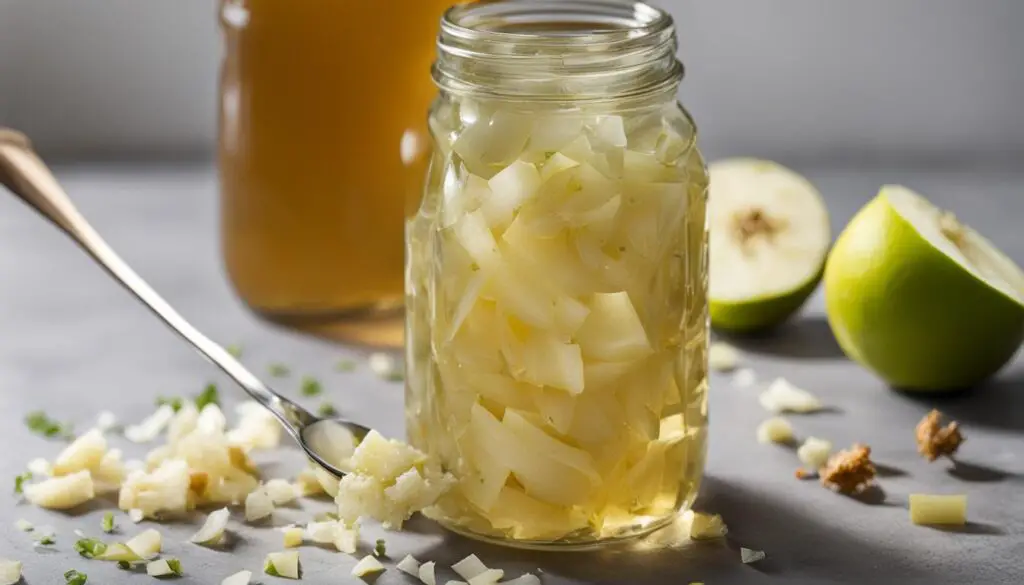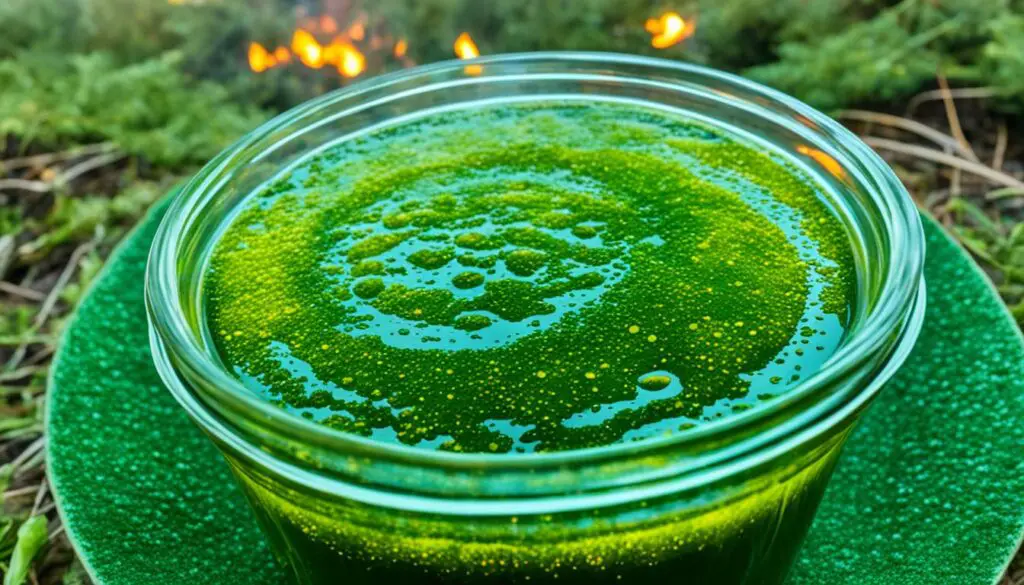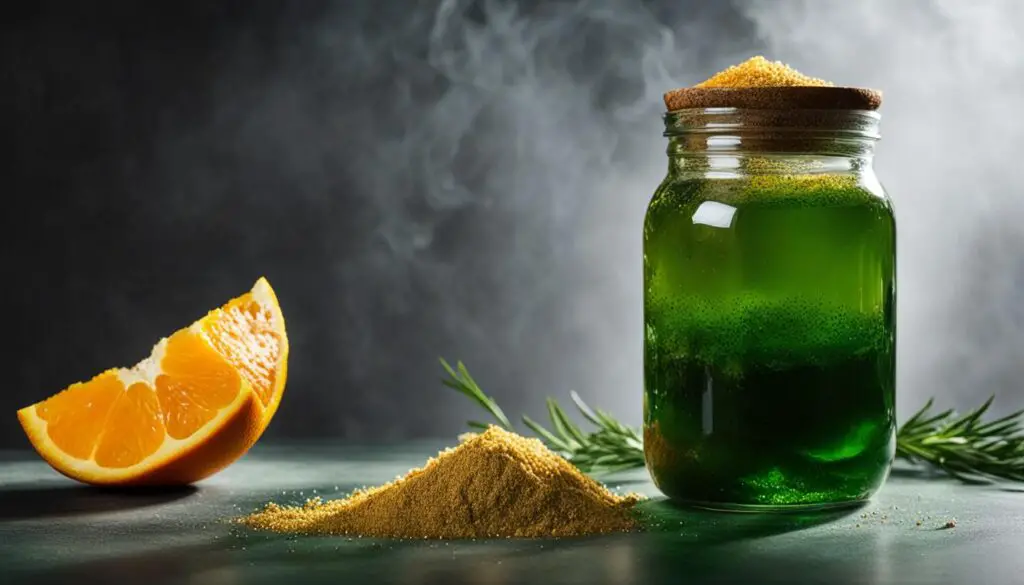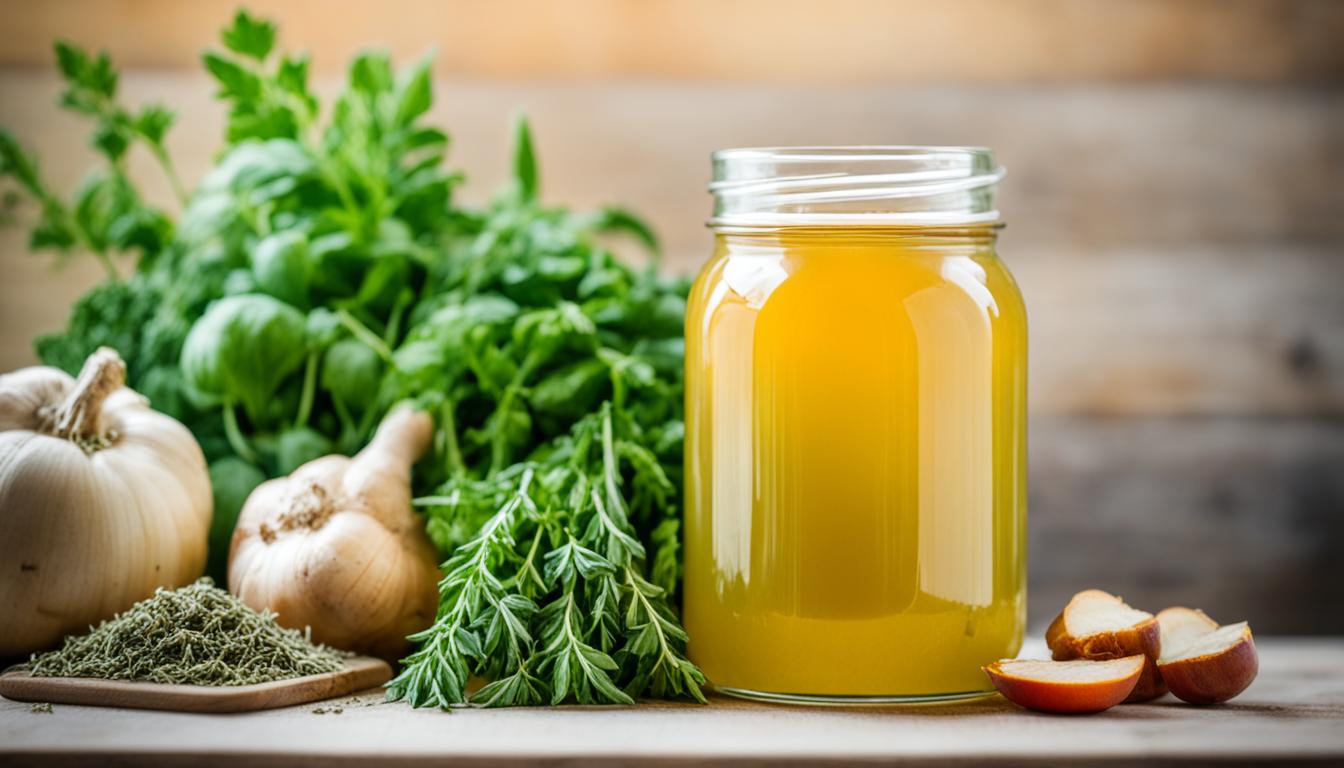If you’ve found yourself wondering, “Why did my fire cider turn green?” you’re not alone. It can be concerning to see a color change in your homemade fire cider, but rest assured, there are reasons behind this unexpected transformation. In this section, we will explore the possible causes of fire cider discoloration and provide troubleshooting tips to help you address this issue effectively.
Key Takeaways:
- Color changes in fire cider can occur due to various factors, including specific ingredients and the fermentation process.
- Understanding fire cider preparation, including the key ingredients and steps involved, is essential to troubleshoot any discoloration issues.
- Possible causes of fire cider turning green include the presence of ingredients like turmeric or the interaction between different components.
- To address fire cider discoloration, follow troubleshooting tips to rectify the issue and regain the desired color.
- Fermented fire cider introduces additional complexities, so it’s important to take into account the impact of fermentation on color changes.
Understanding Fire Cider Preparation

Before we dive into the reasons behind your fire cider turning green, let’s first explore the process of preparing this homemade tonic. Understanding the key ingredients, fermentation process, and steps involved in making fire cider is crucial to troubleshooting any color-related issues.
The Key Ingredients
Fire cider is a potent concoction made from a blend of natural ingredients known for their immune-boosting and digestive properties. The recipe typically includes:
- Fresh horseradish
- Garlic cloves
- Ginger root
- Onions
- Cayenne pepper
- Apple cider vinegar
- Honey
Each ingredient plays a vital role in enhancing the flavor and therapeutic benefits of fire cider. The combination of these powerful components is what makes fire cider so effective.
The Fermentation Process
Fire cider undergoes a fermentation process that enhances its flavors and aids in the extraction of beneficial compounds from the ingredients. During fermentation, the naturally occurring bacteria and yeasts feed on the sugars in the cider, transforming it into a tangy and probiotic-rich tonic.
It’s important to note that fermentation can introduce slight variations in color, taste, and texture, which are all part of the natural transformation process. However, significant color changes, like turning green, may indicate an issue that needs attention.
Steps for Homemade Fire Cider
To prepare your own homemade fire cider, follow these simple steps:
- Chop or grate the horseradish, garlic, ginger, and onions.
- Combine the chopped ingredients in a jar or container.
- Add cayenne pepper and cover the ingredients with apple cider vinegar. Ensure all the ingredients are fully submerged.
- Seal the jar tightly and let it sit in a cool, dark place for three to four weeks.
- After the fermentation period, strain the liquid, discarding the solids.
- Add honey to taste, stirring well until fully incorporated.
- Store the fire cider in a clean, airtight container in the refrigerator.
Now that you understand the preparation process, we can delve into the possible reasons behind your fire cider turning green and how to address this issue effectively.
Possible Reasons for Fire Cider Turning Green

Finding your fire cider has turned green can be perplexing, but there are several factors that can contribute to this color shift. Let’s explore the potential causes and gain insights into the specific ingredients that may cause fire cider to change its color.
1. Herbal Components
Fire cider typically contains a variety of herbal ingredients known for their potent flavors and medicinal properties. Some herbs, such as nettle, parsley, or dandelion, contain chlorophyll, which can give your fire cider a greenish hue. While these green ingredients are desirable, they may contribute to a color change in your fire cider.
2. Oxidation
Oxidation is another common reason for fire cider to turn green. When the ingredients are exposed to air or light for prolonged periods during the preparation or storage process, the oxidation reaction can occur, leading to a change in color. The presence of ingredients like garlic and horseradish, which are prone to oxidation, can accelerate this process.
3. Fermentation
If you’re fermenting your fire cider, the color change can be attributed to the fermentation process. As the beneficial bacteria and yeast in the fermentation process break down the sugars in the ingredients, chemical reactions take place, altering the hue of the fire cider. The interaction between the sugars, alcohol, and other compounds can result in a greenish color.
It’s important to note that while the green coloration may not be as visually appealing, it does not impact the flavor or safety of your fire cider. However, if you prefer a different color, there are steps you can take to troubleshoot the issue and regain the desired hue.
Refer to the table below for a summary of the possible reasons for fire cider turning green:
| Possible Reasons for Fire Cider Turning Green |
|---|
| Presence of chlorophyll-rich herbal ingredients |
| Oxidation caused by exposure to air or light |
| Color changes during fermentation process |
Troubleshooting Fire Cider Discoloration

If you’re wondering why your fire cider has turned green and seeking a solution, you’ve come to the right place. In this section, we will provide troubleshooting tips to help you rectify the issue and regain the desired color in your fire cider.
Identify the Cause
The first step in troubleshooting fire cider discoloration is to identify the underlying cause. Take a closer look at your recipe and fire cider preparation process to pinpoint any potential factors that could have contributed to the color change. Some common causes include:
- Excessive oxidation
- Incorrect ingredient proportions
- Poor quality or spoiled ingredients
- Inadequate fermentation conditions
By understanding the cause, you can effectively address the issue and prevent future occurrences.
Adjust Ingredient Proportions
If the discoloration is due to incorrect ingredient proportions, consider adjusting the recipe for your next batch of fire cider. Experiment with different ratios of herbs, spices, and other ingredients to achieve the desired color. Keep in mind that certain ingredients, such as turmeric, may have a stronger impact on the color of your fire cider.
Taking Preventative Measures
To prevent fire cider discoloration, consider the following preventative measures:
- Store your fire cider in a dark, cool place to minimize oxidation.
- Ensure all ingredients are fresh and of high quality.
- Follow proper fermentation techniques and maintain optimal fermentation conditions.
By implementing these measures, you can reduce the likelihood of color changes in your fire cider.
Seeking Expert Advice
If you’ve tried troubleshooting the issue without success, it may be helpful to seek advice from experienced fire cider makers or fermentation experts. They can provide valuable insights and personalized recommendations based on their expertise.
Remember, fire cider discoloration is a common issue that can be resolved with the right approach. By following these troubleshooting tips, you can regain the vibrant color in your homemade fire cider and continue enjoying its benefits.
Fermented Fire Cider and Color Changes

Fermentation plays a significant role in the making of fire cider, and it can introduce additional complexities when it comes to color changes. As the fermentation process progresses, various factors can influence the color of your fire cider, resulting in deviations from the expected hue. Understanding these color shifts and learning how to manage them is essential for maintaining the desired aesthetic quality of your fermented fire cider.
The primary reason for color changes in fermented fire cider is the interaction between ingredients and the fermentation process itself. During fermentation, the active microorganisms break down sugars in the primary ingredients, releasing natural acids, enzymes, and pigments. These compounds can alter the color of the cider, resulting in shades that may differ from your original batch.
Some ingredients, such as turmeric, horseradish, and citrus fruits, are known for their vibrant colors. When these ingredients are included in a fire cider recipe, their pigments can leach into the liquid during fermentation, contributing to color changes. Additionally, the presence of natural sediments and the accumulation of yeast and bacterial cultures can also impact the overall color of the cider.
Managing and controlling color shifts in fermented fire cider can be challenging but not impossible. One approach is to experiment with different ingredient combinations to achieve the desired color. For example, using fewer pigmented ingredients or adjusting their quantities can help maintain a specific hue. Adding a small amount of an ingredient with a natural color fixative, such as rose hips, may also help stabilize the color of your fire cider during fermentation.
It is important to note that while color changes in fermented fire cider may be visually different from your expectations, they do not necessarily indicate spoilage or loss of quality. In fact, these variations can be a natural part of the fermentation process and may even enhance the flavor and complexity of the final product. However, if you notice any off-putting smells, mold, or signs of contamination, it is advisable to discard the batch and start fresh.
To maintain the quality and appearance of your fire cider, it is recommended to store it in a cool, dark place away from direct sunlight. UV rays from sunlight can accelerate color changes and potentially diminish the overall quality of the cider.
By understanding the intricacies of fermentation and exploring techniques to manage and control color changes in fermented fire cider, you can enjoy a visually appealing and delicious homemade remedy. Embrace the beauty of natural variations in color as you embark on your fire cider-making journey.
Conclusion
In conclusion, understanding why your fire cider turned green can help you troubleshoot the issue effectively. By being aware of the potential causes and employing the appropriate solutions, you can maintain the desired color and quality of your homemade fire cider. Implement the tips provided in this article to enjoy a vibrant and visually appealing fire cider.
Remember, fire cider discoloration can occur due to various factors, such as the ingredients used, the fermentation process, or even environmental conditions. By carefully selecting fresh and high-quality ingredients, following proper preparation techniques, and monitoring the fermentation process, you can minimize the chances of your fire cider turning green.
If you do experience a color shift in your fire cider, don’t panic. Instead, follow the troubleshooting tips discussed in this article. These steps will guide you in identifying the cause of the discoloration and taking appropriate measures to rectify the issue. Remember, patience and experimentation may be required to achieve the desired color in your fire cider.
With these insights and recommendations, you can confidently create fire cider that not only boasts its renowned health benefits but also pleases the eye with its vibrant hues. Enjoy the process of making homemade fire cider, and savor the satisfaction of sipping a perfectly balanced and visually appealing concoction.

